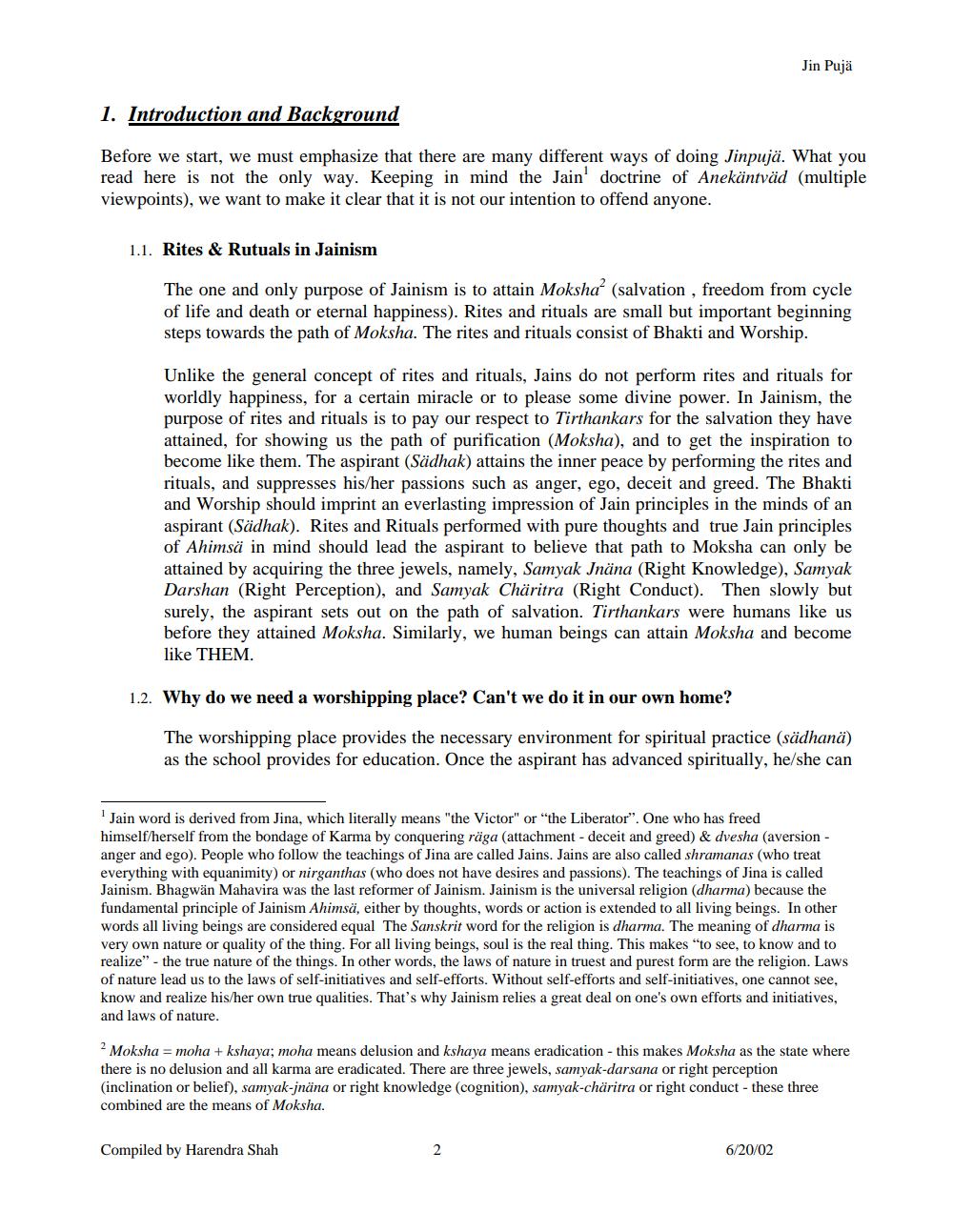Book Title: Jin puja Author(s): Harendra Shah Publisher: USA Jain Center Northern Calfornia View full book textPage 2
________________ Jin Pujä 1. Introduction and Background Before we start, we must emphasize that there are many different ways of doing Jinpujä. What you read here is not the only way. Keeping in mind the Jain' doctrine of Anekäntväd (multiple viewpoints), we want to make it clear that it is not our intention to offend anyone. 1.1. Rites & Rutuals in Jainism The one and only purpose of Jainism is to attain Moksha (salvation , freedom from cycle of life and death or eternal happiness). Rites and rituals are small but important beginning steps towards the path of Moksha. The rites and rituals consist of Bhakti and Worship. Unlike the general concept of rites and rituals, Jains do not perform rites and rituals for worldly happiness, for a certain miracle or to please some divine power. In Jainism, the purpose of rites and rituals is to pay our respect to Tirthankars for the salvation they have attained, for showing us the path of purification (Moksha), and to get the inspiration to become like them. The aspirant (Sädhak) attains the inner peace by performing the rites and rituals, and suppresses his/her passions such as anger, ego, deceit and greed. The Bhakti and Worship should imprint an everlasting impression of Jain principles in the minds of an aspirant (Sädhak). Rites and Rituals performed with pure thoughts and true Jain principles of Ahimsä in mind should lead the aspirant to believe that path to Moksha can only be attained by acquiring the three jewels, namely, Samyak Jnäna (Right Knowledge), Samyak Darshan (Right Perception), and Samyak Chäritra (Right Conduct). Then slowly but surely, the aspirant sets out on the path of salvation. Tirthankars were humans like us before they attained Moksha. Similarly, we human beings can attain Moksha and become like THEM. 1.2. Why do we need a worshipping place? Can't we do it in our own home? The worshipping place provides the necessary environment for spiritual practice (sädhanä) as the school provides for education. Once the aspirant has advanced spiritually, he/she can Jain word is derived from Jina, which literally means "the Victor" or "the Liberator". One who has freed himself/herself from the bondage of Karma by conquering räga (attachment - deceit and greed) & dvesha (aversion - anger and ego). People who follow the teachings of Jina are called Jains. Jains are also called shramanas (who treat everything with equanimity) or nirganthas (who does not have desires and passions). The teachings of Jina is called Jainism. Bhagwan Mahavira was the last reformer of Jainism. Jainism is the universal religion (dharma) because the fundamental principle of Jainism Ahimsä, either by thoughts, words or action is extended to all living beings. In other words all living beings are considered equal The Sanskrit word for the religion is dharma. The meaning of dharma is very own nature or quality of the thing. For all living beings, soul is the real thing. This makes to see, to know and to realize" - the true nature of the things. In other words, the laws of nature in truest and purest form are the religion. Laws of nature lead us to the laws of self-initiatives and self-efforts. Without self-efforts and self-initiatives, one cannot see, know and realize his/her own true qualities. That's why Jainism relies a great deal on one's own efforts and initiatives, and laws of nature. 2 Moksha = moha + kshaya; moha means delusion and kshaya means eradication - this makes Moksha as the state where there is no delusion and all karma are eradicated. There are three jewels, samyak-darsana or right perception (inclination or belief), samyak-inäna or right knowledge (cognition), samyak-chäritra or right conduct - these three combined are the means of Moksha. Compiled by Harendra Shah 6/20/02Page Navigation
1 2 3 4 5 6 7 8 9 10 11 12 13 14 15 16
